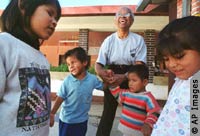02 June 2008
Peace Corps Adapts to a Changing World

Lauren Monsen
Since its founding in 1961 by President John F. Kennedy, the U.S. Peace Corps has sent volunteers to developing nations not only to help provide essential services, but to promote a better understanding between Americans and people of other cultures.
Kennedy hoped the Peace Corps would advance the cause of world peace and friendship, said Ronald Tschetter, the agency’s current director. Today’s Peace Corps has adapted to a changing world while remaining true to its mission, he told reporters recently in New York City on the Peace Corps’ 46th anniversary.
From the beginning, Peace Corps volunteers have lived and worked alongside citizens of host countries, teaching sustainable skills while respecting the local culture. The Peace Corps has served in 139 countries, and projects are designed to meet “host country needs,” said Tschetter.
The largest Peace Corps program is education — including English-language teaching — followed by health programs such as immunization and health education. “The largest single area of our health work is HIV/AIDS prevention, primarily in Africa,” Tschetter said. There are also programs to support small business development, protect the environment, promote advances in agriculture, and counsel young people.
The average age of a Peace Corps volunteer is 27, Tschetter said, “but right now, the oldest volunteer is an 81-year-old woman serving in Thailand.” There are only two requirements to be eligible to join the Peace Corps: A candidate must be at least 18 years of age and be a U.S. citizen.
He said the agency is trying to attract more of the Baby Boom generation — people born between 1946 and 1964. Volunteers in their 50s already may have 30 years of professional experience and can bring a tremendous amount of expertise and skill to the countries in which they serve, he said.
Volunteers are given a place to live in the host country and a living allowance, plus a small stipend when they return from their two-year assignments. They are provided with transportation and medical care while in the Peace Corps.
Although not enriching in a monetary sense, Peace Corps service is deeply rewarding, Tschetter said. Volunteers often describe their service as a life-changing event.
“They teach skills at the grassroots level, they share American values with others around the world, and since they live among the people they serve, they become a part of the local infrastructure,” he said.

Many volunteers extend their assignments for a third year, and sometimes return to the Corps after decades of absence, said Tschetter.
Volunteers frequently report that they feel entirely at home and secure in their host communities, he said. “One young woman serving in a predominantly Muslim country said that if she’s gone for two months from her apartment in California, no one would miss her, but if she’s gone from her adopted village for two hours, people come knocking at her door, asking if she’s all right,” Tschetter recalled.
Tschetter told a reporter from Cameroon that there are now about 140 volunteers in that country. In Cameroon, the Peace Corps’ environmental programs are important because of deforestation and lack of clean drinking water, Tschetter said. “These programs have transformed local villages.”
The Peace Corps is making a difference elsewhere in Africa, he said, citing an active health campaign in Botswana that is helping that country make “good progress against HIV/AIDS.”
The agency has adapted to a rapidly changing world, Tschetter said. “The biggest change is technology. Its impact has been felt even in small villages in India and Africa. Today, almost all of our volunteers have cell phones to facilitate their work and keep in touch with their families.”
However, such changes do not alter the Peace Corps’ fundamental mission, “and as far as I can see into the future, the need for what we’re doing at the grassroots level will always be there,” he said.
Ukraine now hosts the largest contingent of volunteers, between 375 and 400, but “we’ll probably phase down as development continues,” Tschetter said.
The Peace Corps had to leave Ethiopia because of political instability, but it was “recently invited to come back, and we will return in 2007,” Tschetter said. “We will establish an exclusively HIV/AIDS program there, and we may eventually expand into other areas. We’re greatly looking forward to serving the people of Ethiopia again.”
Americans increasingly are aware of the need for greater engagement with the outside world, said Tschetter, and the Peace Corps has been attracting more and more volunteers. After the September 11, 2001, terrorist attacks against New York and Washington, “our applications shot up, and they’ve stayed up,” he said.
Tschetter stressed that the Peace Corps has a presence only in countries that invite it, and that the agency is not part of the U.S. foreign policy apparatus.
“We don’t report to the U.S. State Department; we report directly to the White House,” he said. “It’s important for us to present the real face of America to the countries we serve in.”
— Lauren Monsen is a staff writer for the Bureau of International Information Programs. This article originally appeared on usinfo.state.gov.
